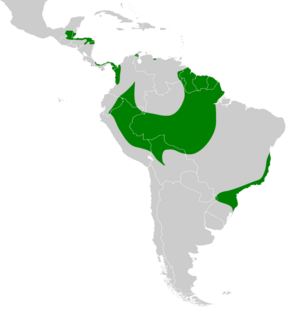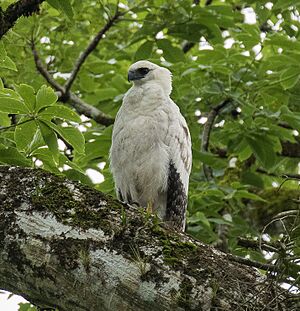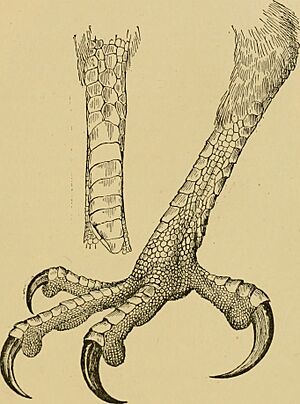Crested eagle facts for kids
Quick facts for kids Crested eagle |
|
|---|---|
 |
|
| Perched in a tree in Bolivia | |
| Conservation status | |
| Scientific classification | |
| Genus: |
Morphnus
|
| Species: |
guianensis
|
 |
|
The crested eagle (Morphnus guianensis) is a large eagle that lives in the Neotropics, which is a big area covering Central and South America. It's the only type of eagle in its group, called Morphnus. These powerful birds can grow up to 89 centimeters (about 35 inches) long. Their wings can spread out to 176 centimeters (about 5.8 feet) wide! They usually weigh up to 3 kilograms (about 6.6 pounds).
Crested eagles have feathers that can be light brownish-gray, dark gray, or even almost black. They have a white throat and a dark spot on their crest, which is a group of feathers on their head. They also have a small dark mask around their eyes. You can find them across Central and South America, but they are not very common. They prefer to live in warm, wet lowland forests. These eagles are strong hunters. They mostly eat small mammals, rodents, snakes, and smaller birds. Even though they live in many places, their numbers are getting smaller. This is mainly because their forest homes are being destroyed. Because of this, they are listed as "Near Threatened" by the IUCN.
About the Crested Eagle
Crested eagles are large but slim birds. They are usually between 71 and 89 centimeters (28 to 35 inches) long. Their wingspan, which is how wide their wings stretch, can be from 138 to 176 centimeters (4.5 to 5.8 feet). Most crested eagles weigh between 1.2 and 3 kilograms (2.6 to 6.6 pounds). Female eagles are usually about 14% larger than males.
These eagles have a big head, which looks even bigger because of their feathery crest. They have bare legs with long talons. Their tail is quite long, measuring 34 to 43 centimeters (13 to 17 inches). Their wings are short but wide and rounded. Eagles that live in forests often have shorter wings. This helps them fly easily through thick trees.
The feathers of a crested eagle can look a bit different from bird to bird. Most adult eagles have a light brownish-gray head, back, and chest. They have a white throat and a dark spot on their crest. Some eagles are darker, with sooty-gray or blackish feathers. Young crested eagles look different. Their head and chest are white, and their back and wings are marbled gray. As they get older, they turn a sandy-gray color. When they fly, their underside looks pale, except for their grayish chest.
Crested eagles sometimes live in the same areas as the Harpy eagle. Harpy eagles are likely close relatives and look a bit similar. There have even been rare sightings of a crested eagle feeding a young harpy eagle when the adult harpy eagles were away!
Where They Live
Crested eagles are found in many countries, but not in large numbers. Their home stretches from northern Guatemala down through Belize, Honduras, Nicaragua, Costa Rica, and Panama. They also live in parts of Colombia, Venezuela, Guyana, Suriname, French Guiana, and Brazil. You can also find them in eastern Ecuador, southeastern Peru, Paraguay, eastern Bolivia, and northern Argentina.
These eagles prefer to live in wet lowland forests. They especially like old, untouched tropical rainforests. They can also be found near rivers or in ravines with trees. Most sightings are from sea level up to 600 meters (about 2,000 feet) high. However, in the Andes Mountains, they can sometimes be seen in forests up to 1,000 meters (about 3,300 feet) or even 1,600 meters (about 5,200 feet) high. They seem to like being close to water, like coasts or rivers.
What They Eat and How They Live
Crested eagles are "still-hunters." This means they often sit quietly on a branch for a long time. They watch the forest carefully for prey. They might avoid competing directly with the larger harpy eagle by hunting smaller animals. However, the crested eagle is still a very strong hunter. Most studies show that they mainly eat small mammals.
Their diet often includes small monkeys, like capuchin monkeys, tamarins, and woolly monkeys. They seem to focus on small to medium-sized monkeys, or young ones from larger species. These monkeys usually weigh from 0.3 to 3 kilograms (0.6 to 6.6 pounds). Other mammals they eat can include tree-dwelling rodents, opossums, sloths, and kinkajous. Studies show that crested eagles are good at hunting small to medium-sized monkeys. They also prefer to hunt the young of even smaller monkey species. In some areas, their main food is opossums, from tiny mouse opossums to larger types. They also hunt many animals that are active at night.
Crested eagles also eat a lot of snakes, both those that live in trees and on the ground. They have been seen eating large boas. Other reptiles they hunt include lizards, like iguanas. Sometimes, they also eat tree frogs. Birds can be a part of their diet too, more so than for harpy eagles. They have been seen catching birds like jays and guans near fruit trees. However, studies show that birds are a smaller part of their diet than reptiles.
Crested eagles are usually seen alone or in pairs, just like most birds of prey. Their breeding season starts around March or April. They build their nests in the main fork of a large, tall forest tree. The nest is often very big but has a shallow cup shape. It's usually hidden among the leaves near the top of the trees. They typically lay two eggs, but usually only one chick hatches. The eggs are dull white and oval-shaped.
The female crested eagle is very dedicated to sitting on the eggs and feeding the chicks. She also protects the chick from strong sun or rain. The male eagle mainly brings food to the nest. He announces his arrival with a loud call. Even after the young eagle learns to fly, it still depends on its parents for a long time. It can take from 16 to 30 months before a young eagle is fully independent. This means that crested eagles usually breed only every other year. This is common for eagles that live in tropical forests.
Their Future
Crested eagles have always lived in small numbers. They can also be hard to spot even in places where they do live. Even though they are found in many areas, their numbers are dropping. Because of this, the IUCN has listed them as "Near Threatened." It's estimated that there are only about 1,000 to 10,000 adult eagles left.
These eagles rely heavily on large, untouched forests. So, they are greatly affected when their forest homes are destroyed. Tropical forests, like the Amazon rainforest, are being cut down and damaged a lot. This means they can't support most of the forest eagles that live there. Crested eagles are believed to have disappeared from several places where they used to breed because the forests were cleared.
Sometimes, local people hunt these eagles. They can be shot if they are seen perched, as they often sit still for a long time. In Mexico, the number of crested eagles is thought to have been cut in half, mostly due to losing their homes. Data shows that the number of crested eagles is decreasing almost everywhere they live.





